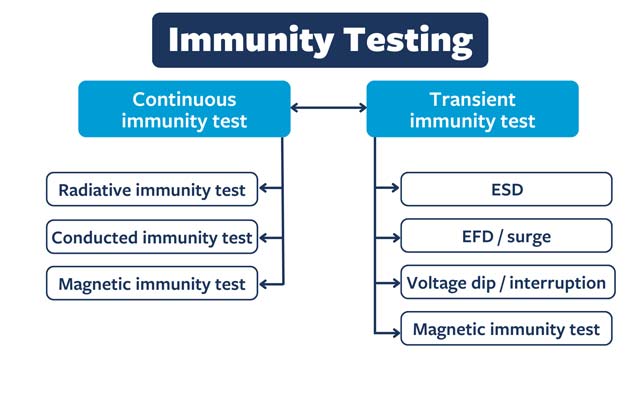Understanding EMC Immunity Testing and Performance Criteria

James Daniels is the General Manager of Element’s Connected Technologies business in the UK, currently responsible for Operations in our Hull, Skelmersdale, Malvern, Wimborne and Oxford laboratories.
Success in EMC (Electromagnetic Compatibility) testing hinges on an understanding of the testing process and the performance criteria that determine compliance. Element Expert James Daniels delves into the basics of EMC immunity testing, alongside an exploration of Performance Criteria A, B, and C, and why your devices need to comply with these performance criteria.
What is EMC immunity testing?
Immunity testing assesses the ability of equipment to function correctly in the presence of Electromagnetic Interference (EMI). When testing for immunity some tests will use continuous (usually modulated) waves and others will involve very short bursts (transient) phenomena. A range of tests are usually applicable, depending on the type of immunity to which you are testing. These include radiated radio frequency, magnetic field, Electrostatic Discharge (ESD) conducted radio frequency, electrical fast transients (EFT), surges, and voltage dips/interruptions.
Exploring 7 Types of EMC Immunity Testing
There are several types of EMC immunity testing, each focusing on specific aspects of electromagnetic interference. Here are the 7 most common types:
- Electrical Fast Transient Testing (EFT): Evaluates device immunity to sudden, high-energy electrical disturbances, mimicking lightning strikes or switching transients.
- Radiated Immunity: Assesses device resilience to external electromagnetic radiation, such as radio transmitters or mobile phones.
- Conducted Immunity Testing: Determines device resistance to electromagnetic interference through power and signal cables.
- Voltage Drop Testing: Tests device reliability during voltage fluctuations and interruptions in power supply.
- ESD Testing: Evaluates device susceptibility to electrostatic discharge through controlled discharges.
- EFT Testing: Assesses device response to short-duration bursts of high-voltage pulses, simulating electrical disturbances.
- Magnetic Field Immunity Testing: Measures device resilience to magnetic fields from sources like power lines or electric motors.

Performance criteria for EMC immunity testing
In the context of testing to commercial standards for the European Union (EU), your device must comply with one of the following summarized general performance criteria, as outlined by standards such as IEC 61000-6-1. These criteria play a crucial role in evaluating the performance of electronic devices during and after EMC testing, providing essential insights into their resilience to electromagnetic disturbances. Compliance with these criteria ensures that products meet the regulatory requirements set forth by the EU, facilitating market access and enhancing product reliability and acceptance.
Performance criteria A
No degradation of performance or loss of function is allowed below a minimum performance level specified by the manufacturer (or what the user may reasonably expect) when the equipment is used as intended.
Criteria A means that your product has performed normally and within specifications that have usually been outlined in the product manual, both during and after the test.
Performance criteria B
No degradation of performance or loss of function is allowed, after the application of the phenomena below a performance level specified by the manufacturer (or what the user may reasonably expect) when the equipment is used as intended.
Criteria B means that the product may have had a temporary loss of function or degradation of performance but after the test has finished, recovers to its normal performance without operator intervention.
Performance criteria C
During and after testing, a temporary loss of function is allowed, provided the function is self-recoverable or can be restored by the operation of the controls or cycling of the power to the EUT by the user in accordance with the manufacturer’s instructions.
Criteria C is similar to B, but the test includes an allowance for operator intervention. For example, this might mean that you need to turn the device back on to resume normal performance.
Which of these three performance criteria you will need to apply will depend upon the test standard that applies to your particular product, and differs for each of the immunity tests.
Why EMC immunity testing performance criteria are essential for your devices?
- Regulatory Compliance: Meeting these criteria is an essential part of complying with harmonized standards, which in turn is generally considered to be the best way of demonstrating conformity to the Essential Requirements of the applicable legislation. This conformity is typically a legal requirement in the EU and other regions, ensuring devices remain operational despite electromagnetic disturbances, as mandated by legislation like the EMC Directive, and the corresponding UK EMC Regulation.
- Market Access: Compliance facilitates market access , allowing products to be sold and distributed without regulatory barriers.
- Product Reliability: Meeting criteria demonstrates higher reliability and robustness against electromagnetic interference, enhancing customer satisfaction and reducing returns and warranty claims.
- Safety: Compliance ensures devices remain safe for users even in the presence of electromagnetic disturbances, preventing potential hazards or malfunctions.
- Cost Savings: Ensuring compliance early in the design and testing phases can save costs associated with rework, redesign, or product recalls due to EMC-related issues discovered later in the product life cycle.
Conclusion
EMC Immunity testing is essential for evaluating the electromagnetic compatibility of electronic devices and ensuring their reliability and performance in various environments. By comprehensively understanding the testing process, including emissions and immunity testing, and adhering to performance criteria outlined in standards like IEC 61000-6-1, manufacturers can achieve regulatory compliance and enhance the market competitiveness of their products. Element's EMC testing laboratories in the US and UK are accredited and approved by NVLAP, A2LA, and UKAS, as well as ISO 9001:2008. We are also a Notified Body in respect to the EMC Directive, and an Approved Body in respect to the UK EMC Regulation.
Find related Resources
Understanding EMC directive harmonized standards
The EMC directive, with associated harmonized standards, requires electrical & electronic equipment manufacturers to meet regulatory requirements.
LEARN MOREHave you tested your product for EMC?
CE EMC testing helps to determine compliance with the EMC directive & provides you with confidence when exporting products worldwide.
READ MOREMore from Element

EMC Testing Services
We provide accredited EMC testing services, helping you to meet regulatory requirements, and improve the performance and safety of products and devices through our global laboratories.

Updates to the EMC Directive 2014/30/EU
Manufacturers must ensure that their products meet these new versions to continue to comply with the essential requirements of the EMC Directive.

CE Marking and Testing
CE marking is a mandatory conformity mark enabling you to enjoy free movement between all 28 Member states.

Product Compliance
Element provides one of the widest range of test and support services in the world aimed at getting your product to market and complying with the V&V requirements.

